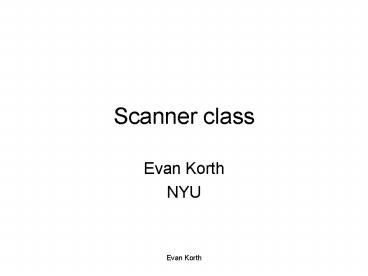Scanner class PowerPoint PPT Presentation
1 / 12
Title: Scanner class
1
Scanner class
- Evan Korth
- NYU
2
Java 1.5 (5.0)s Scanner class
- Prior to Java 1.5 getting input from the console
involved multiple steps. - Java 1.5 introduced the Scanner class which
simplifies console input. It can also be used to
read from files and Strings (among other
sources). - It also can be used for powerful pattern matching
we will not cover pattern matching in this
class. - Scanner is in the Java.util package. So you must
import java.util.Scanner
3
Creating Scanner objects
- We can create a Scanner object by invoking
several different constructors. - Scanner(File source) Constructs a new
Scanner that produces values scanned from the
specified file. - Scanner(InputStream source) Constructs
a new Scanner that produces values scanned from
the specified input stream. - Scanner(Readable source) Constructs a
new Scanner that produces values scanned from the
specified source. - Scanner(String source) Constructs a
new Scanner that produces values scanned from the
specified string.
I have included 4 of the 8 constructors provided
by the API Source java.sun.com
4
Terminology
- Token In computing, a token is a categorized
block of text, usually consisting of indivisible
characters known as lexemes. A token can look
like anything English, gibberish symbols,
anything it just needs to be a useful part of
the structured text. - Delimiter A delimiter is a character used to
separate items of data stored on a computer. It
is used to tell computers to finish processing
one piece of data and move on to the next one.
Most delimiters are characters that will not be
used in the data, such as spaces or commas. It
must also be consistent throughout the data.
Source wikipedia
5
Scanner class
- The Scanner class basically parses input from the
source into tokens by using delimiters to
identify the token boundaries. - The default delimiter is whitespace
- \t\n\x0B\f\r
6
Systems static fields
- static PrintStream err The
"standard" error output stream. - static InputStream in The "standard"
input stream. - static PrintStream out The
"standard" output stream. - Remember You have been using System.out since
your first Hello World program. - Now we see System.in is an InputStream
7
Scanner
- Scanner will read a line of input from its source
(our examples will be from System.in but we have
already seen other sources are possible) - Example
- Scanner sc new Scanner (System.in)
- int i sc.nextInt()
- System.out.println("You entered" i)
- This example reads a single int from System.in
and outputs it to System.out. It does not check
that the user actually entered an int.
8
Next Methods
- String next() Finds and returns the next
complete token from this scanner. - boolean nextBoolean() Scans the next token of
the input into a boolean value and returns that
value. - byte nextByte() Scans the next token of the
input as a byte. - double nextDouble() Scans the next token of the
input as a double. - float nextFloat() Scans the next token of the
input as a float. - int nextInt() Scans the next token of the input
as an int. - String nextLine() Advances this scanner past the
current line and returns the input that was
skipped. - long nextLong() Scans the next token of the
input as a long. - short nextShort() Scans the next token of the
input as a short.
9
InputMismatchExceptions
- InputMismatchException This exception can be
thrown if you try to get the next token using a
next method that does not match the type of the
token
10
hasNext methods
- boolean hasNext() Returns true if this scanner
has another token in its input. - boolean hasNextBoolean() Returns true if the
next token in this scanner's input can be
interpreted as a boolean value using a case
insensitive pattern created from the string
"truefalse". - boolean hasNextByte() Returns true if the next
token in this scanner's input can be interpreted
as a byte value in the default radix using the
nextByte() method. - boolean hasNextDouble() Returns true if the next
token in this scanner's input can be interpreted
as a double value using the nextDouble() method. - boolean hasNextFloat() Returns true if the next
token in this scanner's input can be interpreted
as a float value using the nextFloat() method. - boolean hasNextInt() Returns true if the next
token in this scanner's input can be interpreted
as an int value in the default radix using the
nextInt() method. - BooleanhasNextLine() Returns true if there is
another line in the input of this scanner. - boolean hasNextLong() Returns true if the next
token in this scanner's input can be interpreted
as a long value in the default radix using the
nextLong() method. - boolean hasNextShort() Returns true if the next
token in this scanner's input can be interpreted
as a short value in the default radix using the
nextShort() method.
11
Another example
- Scanner sc new Scanner (System.in)
- System.out.print ("Enter first int ")
- while (sc.hasNextInt())
- int i sc.nextInt()
- System.out.println("You entered " i)
- System.out.print ("Enter another int ")
12
Scanner
- The Scanner class has more powerful abilities.
For example, you can - Change the delimiters
- Use regular expressions
- Read input in different radixes (radices or bases)

